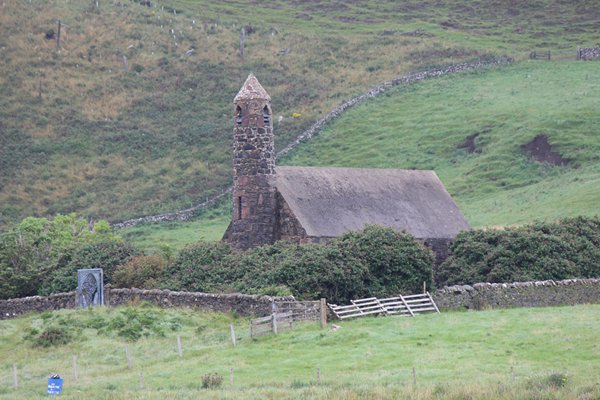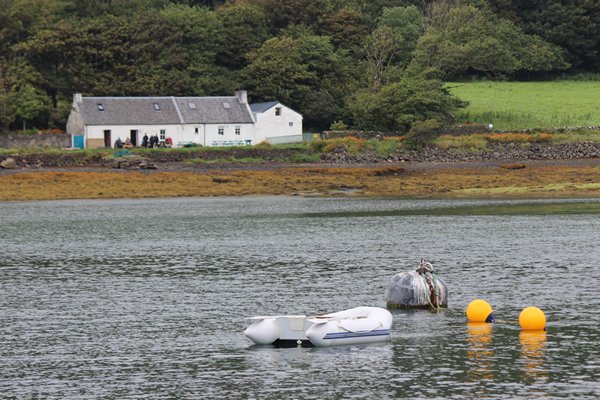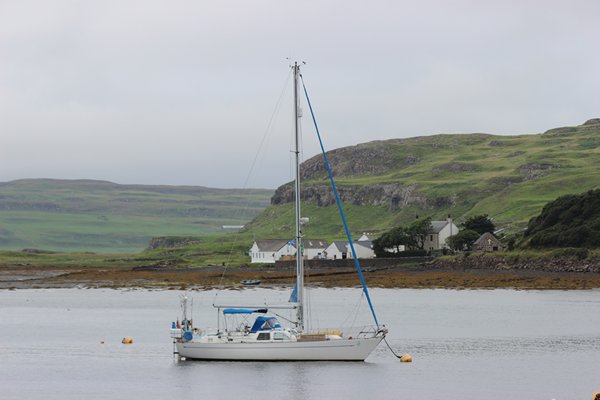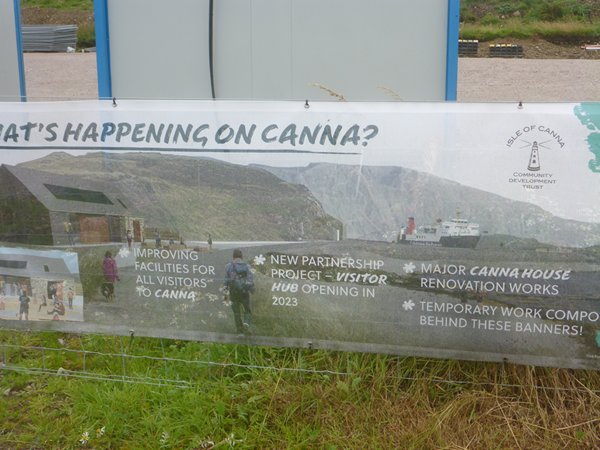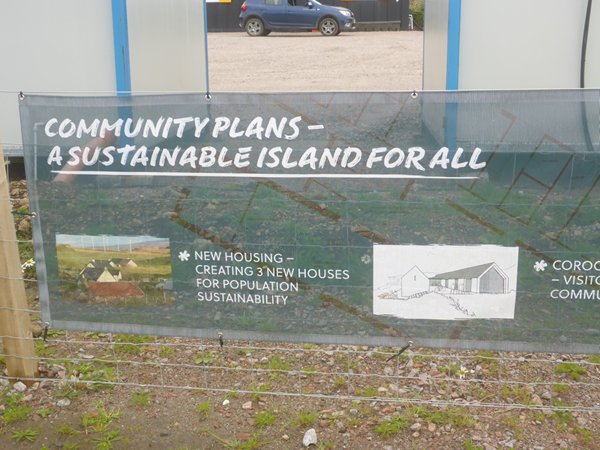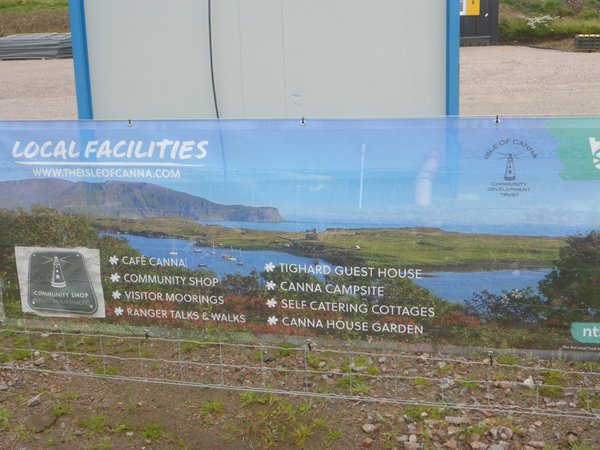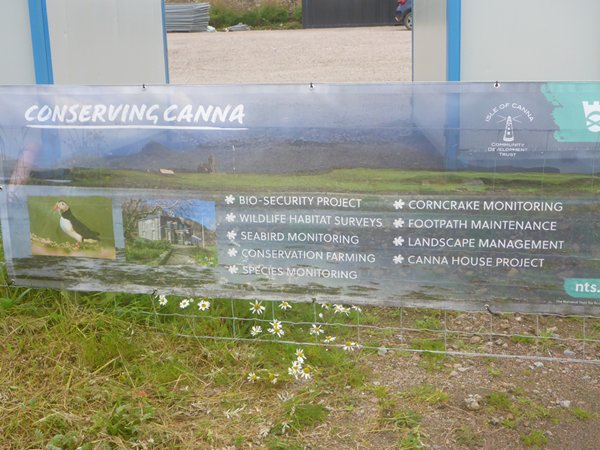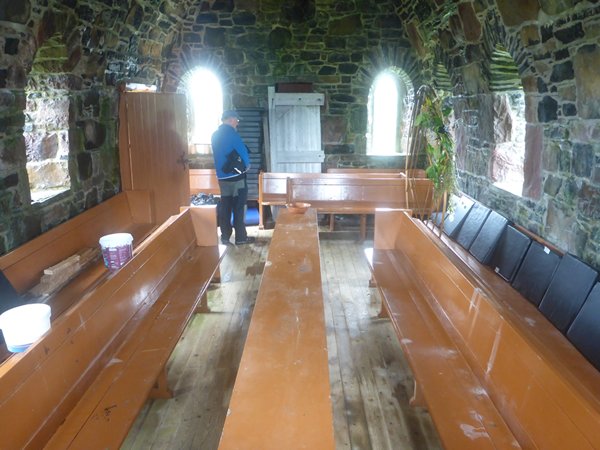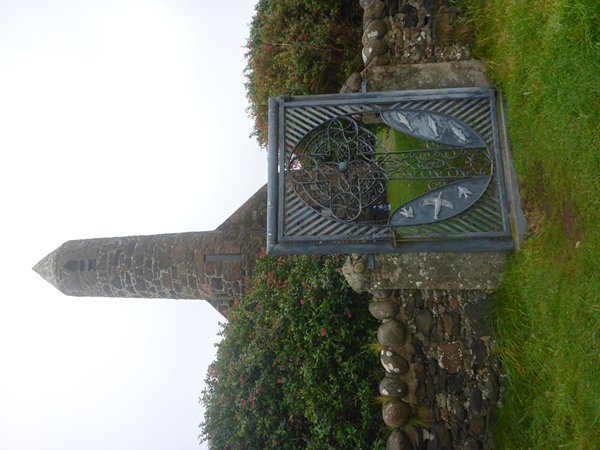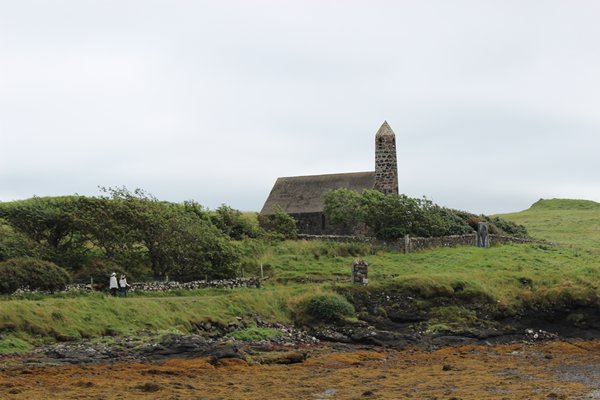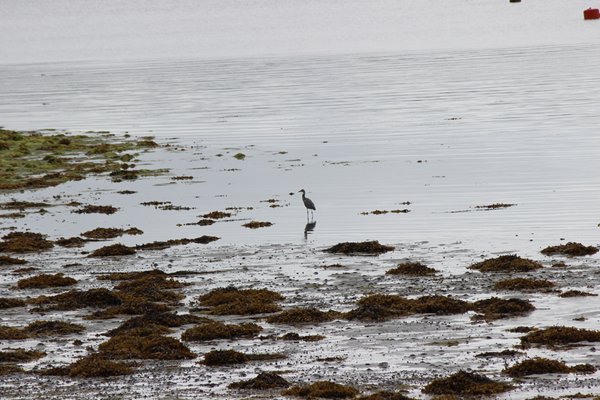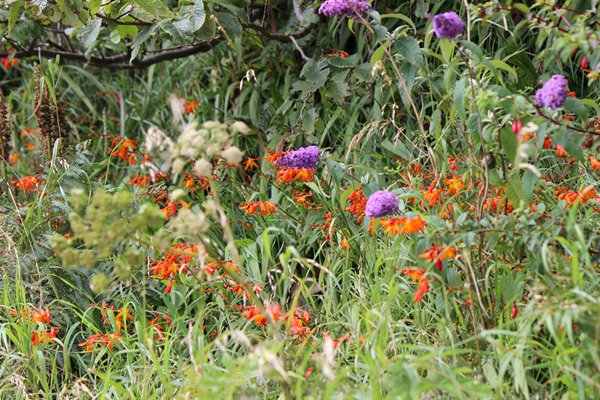Canna in all her beauty

Canna in all her Beauty.
“Well, there are only two yachts showing up on the AIS Barb!” That was different to last time and as we were approaching early in the day, we hoped just enough yachts had left to give us a chance to stay there if only for one night, before we must head for shelter out of the next blow.
We left Kinloch beneath low cloud and glen mist, which soon burned off as the sun’s effect strengthened, and took a couple of hours to motor back on our track full with hope and anticipation. But only one yacht was to be seen leaving. We only needed one buoy of course so when we rounded Rubha Carrinnis on the right of the harbour all was revealed; we had a choice of eight buoys out of the ten to choose from. My heart leapt, another chance to visit this gorgeous place and in what looked like being perfect weather as you will see.
Rob had read that the best place for the dinghy was at the top of the concrete ro-ro ramp and as we would not need the motor on the back for that short, sheltered distance, the dinghy would be easy to carry up. Within minutes we did just that and started exploring inside the little white building on the quay, a kind of self-use visitor centre packed with info and history in the form of photos, brochures and pictures and writing on the walls and a film of locals singing their own songs on constant replay.
Straightaway the warm welcome on Canna, even if not in immediate human form, contrasted to the non-existent and mildly hostile reception on Rum where it is only the natural world that lays itself bare for visitors that inspires a love of the place. Instead of the shop and café being closed here the unmanned shop is well stocked and open 24/7. I say unmanned meaning there is an honesty system of payment, instead of someone on the till. One also pays for the mooring there too, and locals are in presence, cleaning and re-stocking, caring proudly for this excellent facility for all to enjoy. Also, the nearby Canna House gardens are run by locals assisted by volunteers and the abundant produce from their vegetable garden supplies the sixteen residents, the restaurant/bar kitchen and visitors.
Before the ruthless clearance times of the mid-19th century Canna had over 400 residents. Since then, due to the clearances and voluntary and enforced migration, and more recently the efforts of The National Trust for Scotland to re-populate the island that were thwarted by the many restrictions placed on the new residents, one of which was issuing leaseholds for only 20 years at a time, numbers had reduced to 15. Until two and a half months ago the trend was definitely downward, but then for the first time in many years, a new baby was born to the couple who own and run the super little venue Café Canna, Tearoom Restaurant and Bar. The new baby was in training when we wandered in to order beers and a lunch platter. His papa agreed that he was not learning too well as he was fast asleep on his dad’s chest!
Now the island community is following their own path in encouraging people to move to the island, for one thing by building three new affordable homes for future newcomers.
We sat in the sun to devour our ploughman’s before starting out on a walk along the low tide shore path to the catholic church, St Edwards, named after Edward the Confessor that stands out tall and dark on land otherwise interrupted only by smaller local dwellings.
On our stroll around from the quay we had wandered into the modest little Rhu Church with its Irish Celtic allusions in the round tower and simple design, affectionately called the rocket church, set within walls and with escallonia all around the doorway. As you can see the roof leaks in a few places but the local faithful ones are happy to sit there under their umbrellas listening to the sermon.
The Church is a loving memorial built by Allan Thom in 1913 to his father Robert who owned the island prior his death. Robert with his wife were beneficent landlords to the local population and Mrs Thom would encourage the children in to her garden at Canna House to help themselves to fruit and vegetables, with the hope of improving their health. Allan and his wife are buried beneath the round high cross headstone beside the little church.
Setting off on our afternoon walk we came across another little chapel, to St Columba this time. It was once the Post Office and seemingly the Government department is better at building leakproof roofs than the builders of the other two churches.
Just past this chapel is a gateway into a field that leads through a pretty small wood planted by the last laird of the island, John Lorne Campbell who is now buried there himself, his grave marked with a granite headstone with his name in Gaelic. Walking on took us to the ancient site of a monastery from the 7th century and all its outbuildings and facilities including a mill pond. The standing remains of a well-worn high cross on the site of the original chapel bore witness to the thriving community that once lived around it, called Keil or Cille, which made me wonder if St Columba set up the community a century before the assumed date, or at least visited the village. I was reminded of when we were in Glencolmcille or Glen of Columba, in Ireland; so Cille was another version of his name, also used here on Canna. In 1805 there were still 32 buildings from the eighteenth century village on the same site, still in use before clearance for sheep took place in 1851. (Even then some people had to be brought to the island later to look after the sheep!) With all these references to St Columba he surely had to have been here at some time!
Atop a nearby hill was a standing stone with a hole in it. A thumb hole for miscreants whose thumbs were wedged in there in an early punishment along the ‘stocks’ principle. There was a superb view from there, but that would have been little compensation for their all-weather punishment.
Back on the main track we walked past the main farm and its buildings erected in the 1850’s and referred to as the Square and across the 2006 road bridge to Sanday, all the while admiring the mountains of Rum ahead. A small shrine built 72 years ago by Dennis Rutledge, a Benedictine monk, with a Polish made stained glass insert gave a clue as to the dedicatee, stood to our right. A division in the road enabled us to follow the old shoreside track at low tide, flanked on the right by numerous houses, and onward toward St Edward’s, standing alone, in location and attention and locked as we found, because its roof which has leaked since it was built in the 19th century, is considered dangerous.
Just down the hill from the church is the shell of Point House, built by the Thom family for their steamer captain and his family. Now a shelter for sheep, the captain’s wife would have had a fine view of her husband coming safely home.
Through a gate a little further on are paths leading toward two puffin colonies, but we didn’t want to disturb them and so made our way slowly back in the embracing warm sunlight, this time along the new road built single-handedly by ‘Finlay’ in 2018, and for which the residents of the little island are eternally grateful because it means access to and from Canna is no longer low tide dependent.
An elderly gentleman was sitting in front of a white house on our way back and it turned out he was the father of the café/bar owner, on holiday from Norfolk and soaking up the rays.
We couldn’t leave the island without a look around Canna House Gardens. Presently the house is closed for stage two of the renovations, the roof and west windows have been repaired and it should be open again in 2024. All the windows were tightly covered with blinds and the manager of the house and archivist Fiona Mackenzie, told us they spent the last week cataloguing and packing the contents for shipment to an atmosphere-controlled storage site. Another contrast in care of the old house to Kinloch Castle. The last laird, John Lorne Campbell was a Gaelic scholar and writer and his American wife Margaret was a talented photographer and collector of Gaelic songs and folklore, so I imagine there were many books, records and albums to preserve, as well as the period contents.
Volunteers were hard at work in the garden which looked well cared for and apart from the lawns, orchard and vegetable garden there is a unique pear and apple tree, the latter looks a little tired with its broken branch but we were reassured grafts have been taken to ensure it will not be lost forever.
So naturally, being a little thirsty by this time, we enjoyed another beer, sitting outside the bar, before returning to Zoonie, pink faced and very happy after the fabulous day.
Whoever we spoke to asked us how long we were staying, and if a question can ever sound like an invitation, then that question certainly did. What an incredible gem of a place.
A special day was looming and we wanted to be in Mallaig for my 70th so we could easily talk with family and friends, but it was with a high degree of reluctance that we left the next morning while the dew was still on Zoonie’s decks.
You
will gather why Canna is one of my favourite places when you see
the following four photo files of the island!
